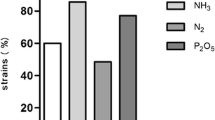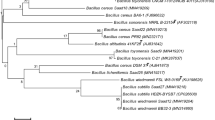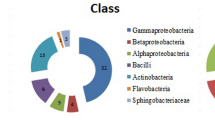Abstract
Development of an effective plant growth promoting rhizobacteria (PGPR) inoculant necessitates the presence of a diverse set of traits that can help its colonization of the rhizosphere and survival under varying environmental conditions. In our investigation, a set of 100 bacterial isolates from the rhizosphere of wheat plants were screened initially on the basis of a seed germination assay; ten bacterial isolates (AW1–AW10) were selected. These isolates were then tested in vitro for specific PGPR traits, such as the production of IAA, siderophore, ammonia, HCN, P solubilization, ACC deaminase activity, acetylene reduction assay and antifungal activity. Of the ten isolates, AW5 was found to be promising for all PGP attributes. An experiment undertaken in the controlled conditions of the National Phytotron Facility revealed the potential of three isolates (AW1, AW5 and AW7) in enhancing the growth parameters of wheat plants. Characterization of these isolates using polyphasic approaches involving both phenotypic and genotypic attributes led to their identification as Bacillus sp. (AW1), Providencia sp. (AW5), and Brevundimonas diminuta (AW7), respectively. These strains could prove effective PGPR inoculants as they possess a number of traits useful for their establishment and proliferation in soil. The genus Providencia is reported for the first time for its PGP potential, using cultural as well as functional attributes to show its suitability as an inoculant for wheat crop.


Similar content being viewed by others
References
Abdul Baki AA, Anderson JD (1973) Vigor determination in soybean seed by multiple criteria. Crop Sci 13:630–633
Ahmad F, Ahmad I, Khan MS (2008) Screening of free-living rhizospheric bacteria for their multiple plant growth promoting activities. Microbiol Res 1631:73–181
Antoun H, Kloepper JW (2001) Plant growth promoting rhizobacteria. In: Brenner S, Miller JH (eds) Encyclopedia of genetics. Academic, New York, pp 1477–1480
Bellis P, Ercolani GL (2001) Growth interactions during bacterial colonization of seedling rootlets. Appl Environ Microbiol 67:1945–1948
Blumer C, Hass D (2000) Mechanism, regulation, and ecological role of bacterial cyanide biosynthesis. Arch Microbiol 173:170–177
Burd GI, Dixon DG, Glick BR (2000) Plant growth promoting bacteria that decrease heavy metal toxicity in plants. Can J Microbiol 46:237–245
Cappuccino JG, Sherman N (1992) Microbiology: a laboratory manual. Addison-Wesley, New York
Cattelan AJ, Hartel PG, Fuhrmann JJ (1999) Screening for plant growth-promoting rhizobacteria to promote early soybean growth. Soil Sci Soc Am J 63:1670–1680
Dennis C, Webster J (1971) Antagonistic properties of species-groups of Trichoderma I. Production of non-volatile antibiotics. Trans Br Mycol Soc 57:25–39
Dilantha F, Nakkeeran S, Yilan Z (2006) Biosynthesis of antibiotics by PGPR and its relation in biocontrol of plant diseases. PGPR Biocontrol Biofert 67-109
Duffy BK, Ownley BH, Weller DM (1997) Soil chemical and physical properties associated with suppression of take-all of wheat by Trichoderma koningii. Phytopathology 87:1118–1124
Dye DW (1962) The inadequacy of the usual determinative tests for identification of Xanthomonas sp. New Zealand J Sci 5:393–416
Fischer SE, Fischer SI, Magris S, Mori GB (2007) Isolation and characterization of bacteria from the rhizosphere of wheat. World J Microbiol Biotechnol 23:895–903
Flaishman MA, Eyal ZA, Zilberstein A, Voisard C, Hass D (1996) Suppression of Septoria tritci blotch and leaf rust of wheat by recombinant cyanide producing strains of Pseudomonas putida. Mol Plant Microbe Interact 9:642–645
Forchetti G, Masciarelli O, Alemano S, Alvarez D, Abdala G (2007) Endophytic bacteria in sunflower (Helianthus annuus L.): isolation, characterization, production of jasmonates and abscisic acid in culture medium. Appl Microbiol Biotechnol 76:1145–1152
Gholami A, Shahsavani S, Nezarat S (2009) The effect of Plant Growth Promoting Rhizobacteria (PGPR) on germination, seedling growth and yield of maize. Int J Biol Life Sci 1(1):35–40
Glick BR (1995) The enhancement of plant growth by free-living bacteria. Can J Microbiol 41:109–117
Glick BR, Patten CL, Holguin G, Penrose DM (1999) Biochemical and genetic mechanisms used by plant growth-promoting bacteria. Imperial College Press, London
Gordon AS, Weber RP (1951) Colorimetric estimation of indole acetic acid. Plant Physiol 26:192–195
Holt JG, Krieg NR, Sneath PHA, Staley JT, Williams ST (1994) Bergey’s manual of determinative bacteriology, 9th edn. Williams and Wilkins, Baltimore
Javier DC, Milagros LB, Ricardo PG (2004) Screening for plant growth-promoting rhizobacteria in Chamaecytisus proliferus (tagasaste), a forage tree-shrub legume endemic to the Canary Islands. Plant Soil 266:261–272
Jeffries S, Gianinazzi S, Perotto S, Turnau K, Barea JM (2003) The contribution of arbuscular mycorrhizal fungi in sustainable maintenance of plant health and soil fertility. Biol Fertil Soils 37:1–16
Karlidag H, Esitken A, Turan M, Sahin F (2007) Effects of root inoculation of plant growth promoting rhizobacteria (PGPR) on yield, growth and nutrient element contents of leaves of apple. Sci Hortic 114:16–20
Khalid A, Arshad M, Zahir ZA (2004) Screening plant growth promoting rhizobacteria for improving growth and yield of wheat. J Appl Microbiol 96(3):473–48
Kloepper JW, Schroth MN (1978) Plant growth promoting rhizobacteria on radish. In: Proceedings of the 4th International Conference on Plant Pathogenic Bacteria, vol 2. Station de Pathologie Vegetale et Phytobacteriologie, INRA, Angers, France, pp 879–882
Kremer RJ, Souissi T (2001) Cyanide production by rhizobacteria and potential for suppression of weed seedling growth. Curr Microbiol 43:182–186
Lowry OH, Rosebrough NJ, Farr AL, Randall RJ (1951) Protein measurement with folin-phenol reagent. J Biol Chem 193:265–275
Maatallah J, Berraho EB, Munoz S, Sanjuan J, Lluch C (2002) Phenotypic and molecular characterization of chickpea rhizobia isolated from different areas of Morocco. J Appl Microbiol 93:531–540
Nain L, Rana A, Joshi M, Jadhav SD, Kumar D, Shivay YS, Paul S, Prasanna R (2010) Evaluation of synergistic effects of bacterial and cyanobacterial strains as biofertilizers for wheat. Plant Soil 331:217–230
Pandey A, Trivedi P, Kumar B, Palni LMS (2006) Characterization of a phosphate solubilizing and antagonistic strain of Pseudomonas putida (B0) isolated from a sub-alpine location in the Indian central Himalaya. Curr Microbiol 53:102–107
Penrose DM, Glick BR (2003) Methods for isolating and characterizing of ACC deaminase-containing plant growth promoting rhizobacteria. Plant Physiol 118:10–15
Pikovskaya RI (1948) Mobilization of phosphorous in soil in connection with vital activity of some microbial species. Mikrobiologiya 17:362–370
Rauss K (1962) A proposal for the nomenclature and classification of the Proteus and Providencia groups. Institute of Microbiology University Medical School Pecs, Hungry. Int Bullet Bacteriol Nomencl Taxon 12:53–64
Rennie RJ (1981) A single medium for isolation of Acetylene reducing (dinitrozen fixing) bacteria from soil. Can J Microbiol 27:8–14
Ross IL, Alami Y, Harvey PR, Achouak W, Ryder MH (2000) Genetic diversity and biological control activity of novel species of closely related Pseudomonads isolated from wheat field soils in South Australia. Appl Environ Microbiol 66:1609–1616
Ryu CM, Farag MA, Hu CH, Reddy MS, Wei HX, Pare PW, Kloepper JW (2003) Bacterial volatiles promote growth in Arabidopsis. Proc Natl Acad Sci USA 100:4927–4932
Salantur A, Ozturk A, Akten S (2006) Growth and yield response of spring wheat (Triticum aestivum L.) to inoculation with rhizobacteria. Plant Soil Environ 52(3):111–118
Sambrook J, Fritsch EF, Maniatis T (1989) Molecular cloning: a laboratory manual. Cold Spring Harbor Laboratory, Cold Spring harbor
Schwyn B, Neilands JB (1987) Universal chemical assay for the detection and determination of siderophores. Anal Biochem 160:47–56
Selvakumar G, Kundu S, Gupta AD, Shouche YS, Gupta HS (2008) Isolation and characterization of Nonrhizobial plant growth promoting bacteria from Nodules of Kudzu (Pueraria thunbergiana) and their effect on wheat seedling growth. Curr Microbiol 56:134–139
Shende ST, Apte RG, Singh T (1977) Influence of Azotobacter on germination of rice and cotton seeds. Curr Sci 46(19):675–676
Wu SC, Cao ZH, Li ZG, Cheung KC, Wong MH (2005) Effects of biofertilizer containing N-fixer, P and K solubilizers and AM fungi on maize growth: a greenhouse trial. Geoderma 125:155–166
Zarrin F, Saleemi M, Zia M, Sultan T, Aslam M, Rehman RU, Chaudhary FM (2009) Antifungal activity of plant growth-promoting rhizobacteria isolates against Rhizoctonia solani in wheat. Afr J Biotechnol 8(2):219–225
Acknowledgments
The authors are grateful to the Indian Council of Agricultural Research (ICAR), New Delhi for funding the AMAAS project of this research work. We are thankful to the Division of Microbiology, IARI, New Delhi for providing the necessary facilities for undertaking this study.
Author information
Authors and Affiliations
Corresponding author
Rights and permissions
About this article
Cite this article
Rana, A., Saharan, B., Joshi, M. et al. Identification of multi-trait PGPR isolates and evaluating their potential as inoculants for wheat. Ann Microbiol 61, 893–900 (2011). https://doi.org/10.1007/s13213-011-0211-z
Received:
Accepted:
Published:
Issue Date:
DOI: https://doi.org/10.1007/s13213-011-0211-z




